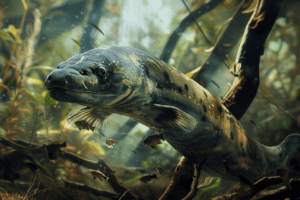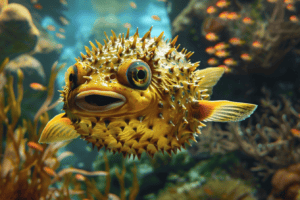Sturgeon, often referred to as “living fossils,” have been around for over 200 million years.
These armored giants have a unique biology that has fascinated scientists for centuries.
From their size to their lifespan, sturgeon are truly remarkable creatures that have adapted to survive in some of the harshest environments on Earth.

One of the most striking features of sturgeon is their size. These fish can grow to be over 20 feet long and weigh up to 1,500 pounds.
Despite their massive size, sturgeon are surprisingly agile and can navigate through even the narrowest of waterways.
Their long, streamlined bodies and powerful tails allow them to swim against strong currents and make quick turns to avoid predators.
Sturgeon also have a unique reproductive system. Unlike most fish, sturgeon do not lay eggs in the water.
Instead, they deposit their eggs in shallow gravel beds, where they are fertilized by the male.
The eggs then develop into larvae, which remain in the gravel for several months before hatching.
This adaptation ensures that the young sturgeon are protected from predators during their most vulnerable stage of life.
Sturgeon Species Showcase

Ancient Lineage
Sturgeon are one of the oldest species of fish in the world, with a history dating back over 200 million years.
They are known for their unique biology, which includes bony plates instead of scales, and a long, pointed snout that is used to stir up sediment on the riverbed.
One of the most fascinating aspects of sturgeon biology is their ability to live for over 100 years.
In fact, some species of sturgeon are known to live for up to 150 years!
This is due to their slow growth rate and low reproductive rate, which helps them to conserve energy and live longer.
Geographic Distribution
Sturgeon are found in rivers and lakes all over the world, from North America to Europe and Asia.
Some of the most well-known species of sturgeon include the Beluga sturgeon, which is found in the Caspian and Black Sea basins, and the White sturgeon, which is found in the Pacific Northwest of North America.
Interestingly, the geographic distribution of sturgeon has changed over time due to human activities such as overfishing and damming of rivers.
Many species of sturgeon are now considered endangered or critically endangered, which highlights the importance of conservation efforts to protect these ancient and unique fish.
In conclusion, sturgeon are a fascinating and important species of fish with a unique biology and long history on Earth.
By learning more about these armored giants and their geographic distribution, we can better appreciate the incredible diversity of life on our planet and work towards protecting it for future generations.
Anatomy of Sturgeon

Sturgeon are unique and fascinating creatures with a distinctive anatomy that sets them apart from other fish.
In this section, we will explore the various components of sturgeon anatomy that make them such formidable armored giants.
Armor-Like Scales
One of the most striking features of sturgeon is their armor-like scales, which cover their entire body.
These scales, known as scutes, are made of bone and are arranged in rows along the length of the fish’s body.
The scutes are covered by a layer of tough, keratinized skin, which gives them their characteristic shine.
The scutes not only provide protection from predators but also help sturgeon navigate their environment.
The scutes are highly sensitive to pressure changes and can detect even the slightest movements in the water, allowing sturgeon to locate prey and avoid obstacles with incredible precision.
Unique Barbels
Another distinctive feature of sturgeon anatomy is their long, whisker-like barbels, which protrude from their snouts.
These barbels are covered in taste buds and are used to detect food in the murky depths where sturgeon typically live.
The barbels also play an important role in sturgeon reproduction.
Male sturgeon use their barbels to locate and court potential mates, while females use their barbels to identify suitable spawning sites.
Tail Structure
Sturgeon have a powerful tail that allows them to swim upstream against strong currents.
Unlike most fish, which have a single fin on their back, sturgeon have several small fins along their back and a large, crescent-shaped tail fin.
The tail fin, or caudal fin, is the primary source of propulsion for sturgeon.
It is supported by a complex network of muscles and bones, which allow sturgeon to generate incredible amounts of force and swim at high speeds for extended periods.
Overall, the unique anatomy of sturgeon is a testament to their remarkable adaptability and resilience.
From their armor-like scales to their sensitive barbels and powerful tail, sturgeon are perfectly adapted to their aquatic environment, making them truly one of a kind.
Reproduction and Lifecycle

Spawning Rituals
Sturgeon are known for their unique spawning rituals.
During the spawning season, which typically occurs in the spring, male sturgeon will swim upstream to shallow waters and begin to create nests in the gravel.
These nests, also known as redds, are used to protect the eggs from predators and provide a safe environment for them to hatch.
Female sturgeon will then swim upstream to the male’s nest and lay their eggs in the redds.
The male will then release his sperm, fertilizing the eggs.
After fertilization, the female will cover the eggs with gravel, providing additional protection.
Sturgeon are known to be a long-lived species and can reproduce multiple times throughout their lifetime.
The females can lay anywhere from a few thousand to several million eggs in a single spawning season.
Growth and Maturity
Sturgeon are slow-growing fish and can take several years to reach maturity.
The age at which sturgeon reach maturity varies by species, but it can take anywhere from 4 to 20 years for a sturgeon to become sexually mature.
Once sturgeon reach maturity, they can grow rapidly, with some species growing up to 10 feet in length and weighing over 1,000 pounds.
Sturgeon can live for several decades, with some species living up to 100 years.
It is important to note that sturgeon populations have been declining due to overfishing and habitat destruction.
Conservation efforts are underway to protect and restore sturgeon populations, ensuring that these armored giants can continue to thrive in their natural habitats for generations to come.
Conservation Efforts

Threats to Survival
Sturgeon populations have been declining worldwide due to several factors, including overfishing, habitat loss, and pollution.
The Beluga sturgeon, for example, is critically endangered and faces a high risk of extinction.
The construction of dams and other barriers also prevents sturgeon from reaching their spawning grounds, reducing their ability to reproduce.
Protection Strategies
To protect sturgeon populations, conservationists have implemented several strategies.
One such approach is the creation of sturgeon hatcheries, where young sturgeon are raised in a controlled environment and then released into the wild.
This helps to boost wild populations and increase genetic diversity.
Another strategy is the regulation of fishing practices.
Many countries have implemented fishing quotas and restrictions on the size and age of sturgeon that can be caught.
This helps to prevent overfishing and allows populations to recover.
Efforts are also being made to restore sturgeon habitats.
This includes removing barriers to migration, restoring rivers and wetlands, and reducing pollution levels.
By improving the health of these ecosystems, sturgeon populations can thrive and contribute to the overall health of the environment.
Overall, the conservation efforts being made to protect sturgeon populations are crucial to their survival.
With continued dedication and support, these armored giants can continue to thrive in our waters for generations to come.
Frequently Asked Questions

How have sturgeons survived since the age of dinosaurs?
Sturgeons are one of the oldest fish species in the world, having survived since the age of dinosaurs.
They have managed to survive for so long due to their unique biology and adaptability.
Sturgeons have a cartilaginous skeleton, which provides flexibility and durability, making them less prone to injury and more resilient to environmental changes.
Additionally, sturgeons are able to survive in low-oxygen environments, which other fish species cannot tolerate.
What makes sturgeons unique compared to other fish species?
Sturgeons are unique compared to other fish species in many ways. For one, they have a long lifespan, with some species living up to 100 years.
They are also among the largest freshwater fish, with some species growing up to 18 feet long and weighing over 1,500 pounds.
They have a distinctive body shape, with five rows of bony plates known as scutes that run along their sides, back, and belly.
Finally, sturgeons are anadromous, meaning they spend part of their life in freshwater and part in saltwater, making them adaptable to different environments.
Can you explain why sturgeons are often referred to as ‘living fossils’?
Sturgeons are often referred to as ‘living fossils’ because they have remained virtually unchanged for millions of years.
Their unique biology has allowed them to survive through multiple mass extinctions, making them one of the oldest and most primitive living species on Earth.
What are the main reasons behind the decline of sturgeon populations?
Sturgeon populations have declined significantly in recent years due to overfishing, habitat loss, pollution, and dam construction.
Sturgeons are highly valued for their caviar, which has led to overfishing and poaching.
Additionally, the construction of dams has disrupted their natural migration patterns, while pollution and habitat loss have impacted their ability to reproduce and survive.
How do sturgeons contribute to their aquatic ecosystems?
Sturgeons play an important role in their aquatic ecosystems.
As a keystone species, they help to maintain the balance of the food chain by feeding on smaller fish and invertebrates, while also providing food for larger predators.
Additionally, sturgeons are important for nutrient cycling, as they excrete nutrients that help to fertilize the surrounding ecosystem.
What conservation efforts are in place to protect sturgeon species?
There are several conservation efforts in place to protect sturgeon species.
These include implementing fishing quotas and regulations, restoring damaged habitats, and breeding sturgeons in captivity for release into the wild.
Additionally, there are efforts to reduce pollution and improve water quality, as well as initiatives to educate the public about the importance of sturgeon conservation.









